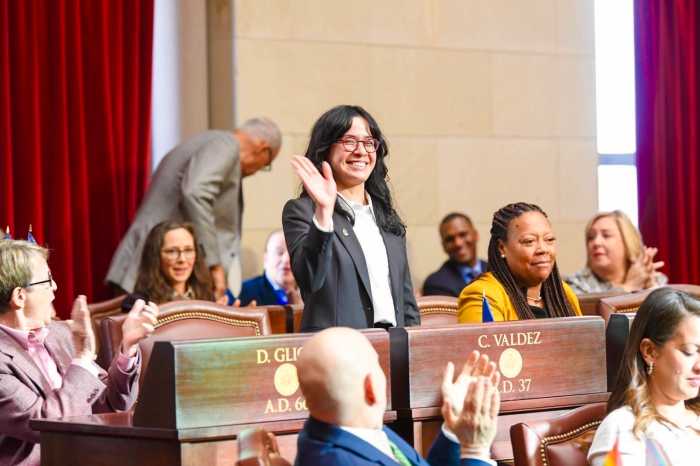Park Slope Food Coop won’t be moving into your neighborhood — at least, not yet.
One of the world’s largest worker-owned cooperatives, Park Slope Food Coop (PSFC) currently has 17,000 members — and more are constantly applying, Joe Holtz, general manager and general coordinator, said.
With interest from more prospective members than it can serve, PSFC is considering a possible second location. But other coops aren’t sure if this would help or hurt the coop community overall.
PSFC aims to keep its member pool steady, accepting new members only as current ones leave. With 17,000 people, some generally leave the coop each week, Holtz said, allowing room for new members hungry for organic products at affordable prices. New members must attend an orientation before being allowed to shop, and the seats tend to fill up quickly, Holtz said.
“People still put up with it and want to join,” Holtz said. “If we look at the world in a positive way, say ‘there’s a positive thing, let’s do more of it.’ The world wants coops? Fine. But then that hasn’t solved our problem of having more people who want to join [than] can join.”
A ‘Second Location Study Committee’ has been assigned to research and decide whether to make a proposal to proceed toward a second location, Holtz said. The coop released a poll in early March asking what neighborhoods people would want a second PSFC in, including Bay Ridge and Astoria, Queens, and the coop community was invited to a meeting March 15 to discuss the idea.
Holtz, 68, has been with the coop since it opened in 1973. It was the first of its kind in the city, and Holtz was its first paid employee. There are now 77 full-time and a few part-time employees, along with regular members who work shifts. In the worker-owned cooperative model, each member is considered a “worker-owner” who helps run the coop, keeping costs for quality products as low as possible. For PSFC, that means working 2.75 hours every four weeks. Each member can also vote on any new initiatives for the business.
PSFC bought its building in 1980, then two others in 1988 and 1999, respectively.
Coop Cooperation
Along with Flatbush Food Coop, founded in 1976, PSFC provides advice and assistance to other coops. Once members have been a part of PSFC for 12 months, they can work at other coops to count toward their monthly hours.
This makes it easier for Celena Mayo, 52, and her husband to be members at both PSFC and Lefferts Community Food Coop, which is around the corner from their home. She loves having selections beyond “one variety of something wrapped in cellophane,” like many chain groceries and even mom-and-pop stores might offer, she said.
“I really like the idea of being able to have a say in the food that we eat. I like the fact that we both support small farmers and support the neighborhood,” Mayo said.
Other NYC food coops include Bushwick Food Coop, Lefferts Community Food Coop, Windsor Terrace Food Coop, Bay Ridge Food Coop, Greene Hill Food Coop and the in-progress Central Brooklyn Food Coop. PSFC and Flatbush Food Coop have also assisted the 4th Street Food Coop in Manhattan.
Greene Hill Food Coop opened its new location at 1083 Fulton St. on Aug. 4 with help expected from PSFC after it was forced to leave its former one at 18 Putnam Ave. by May 1. The coop, founded to serve Fort Greene, Clinton Hill and surrounding neighborhoods, relied on an Indiegogo campaign and member loans to relocate.
“When we were looking to relocate we needed to be very cooperative in that we’re not depleting members from another operation,” Matthew Talmage, a Greene Hill Food Coop board member, said.
The coop’s committees used the time the coop was closed to “hone their processes,” Talmage, 51, said. Greene Hill will receive a forthcoming loan from PSFC, which also gave them a loan in 2014.
“[PSFC] has been supportive in that sense as well as organizationally, restructuring and making sure the operation is even more solid than it had been. They’re very helpful with advice because they have so many years of experience in it,” he said.
Meanwhile, on the other side of Prospect Park, the smaller, newer Lefferts Community Food Coop is hoping to keep its doors open, holding a fundraiser that will run until the end of September. Last week, Lefferts Community Food Coop received a gift of $2,500 from the Cooperative Economics Alliance of New York City, but hasn’t reached a deal with PSFC for loan assistance, Elizabeth Oliver, 39, said, calling it a “chicken-and-egg” situation.
“We want to grow, but can’t get more members unless we can make improvements to the store and expand inventory,” she said. “If we had that little boost from [PSFC], we feel confident we could really kick things up a bit.”
Lefferts Community Food Coop started as a buying club in 2009 at board member Karen Oh’s house before becoming a brick-and-mortar store in November 2014. The first two years they didn’t pay rent; the building’s owner is a friend of a coop member. The coop now pays below market rent, but wants to prepare for when the building is eventually sold.
“It’s a very different landscape than when Park Slope Food Coop came around,” Oliver said. “[We] always come back to the coop principle: coops cooperating with each other, not just within their own coop. We’ve seen a little bit of Park Slope trying to help out.”
Impact of expansion
There’s certainly concern among coops about a potential second PSFC, but first the proposal must be voted on — if the committee decides there still is a proposal, Holtz said.
PSFC is an “amazing institution” with the power to help grow more coops in Brooklyn, which are “super necessary” and could benefit many communities, Oliver said.
“To put the other idea in of opening another coop just seems crazy to me,” she said.
Another PSFC could hinder the efforts of existing food coops.
“If they were to open up an operation near any one of the existing coops, I don’t think the two would be able to survive in the same place,” Talmage said.
Another location would likely impact new coops too. Central Brooklyn Food Coop aims to open in or near Bed-Stuy and Crown Heights. If another PSFC opens in Central Brooklyn, that could complicate their efforts to attract members.
“I want to take that into account — the fact that we’re not going to stop being supportive,” Holtz said.
Talmage also wonders whether the same structure that worked to create PSFC in 1973 would work today.
“People are wondering if the success of Park Slope Food Coop might have been the perfect matrix of situation: real estate at the time, organization, price, neighborhood dynamics — all of that coming together,” he said. “What started as a ragtag group like other food coops, in every one of those regards, the situation has changed so much from the early ’70s that following the exact same sort of buildup structure might not work again. Can doing the exact same thing again be a success? Who’s to say?”
The cost and effort of a new location could affect PSFC’s ability to continue helping other coops. The goal for all of NYC’s food coops remains the same: “quality healthy food to make everybody’s life better,” Talmage said.
“All other coops are hoping to be involved in [PSFC’s] deliberate process too,” he said. “Ultimately the strength of one coop is going to psychologically and publicly help any other food coop. [It can be] a positive force for all when it’s successful.”





































